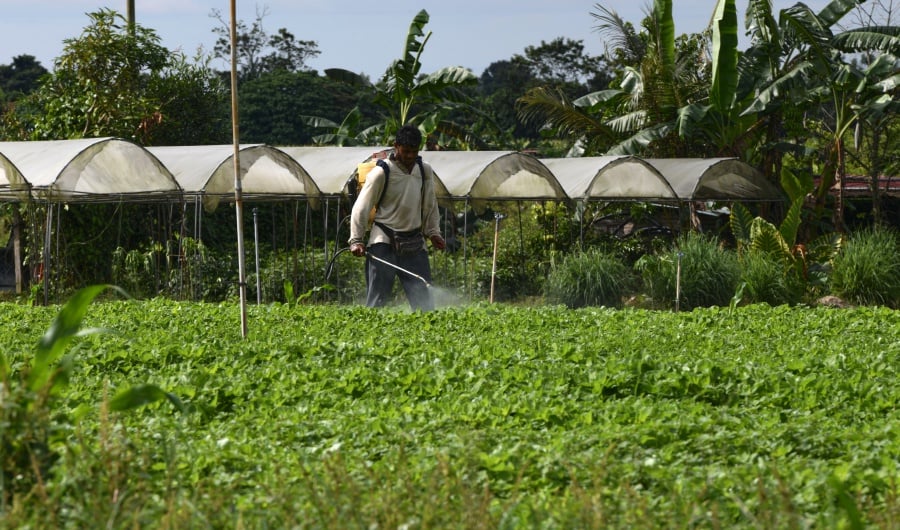
Agriculture today needs to sustain ecosystem health and drive restoration by reversing soil degradation and overcoming environmental problems from the intensive use of chemicals in modern agriculture. – Bernama file pic
IN the 21st century, agriculture has to respond to challenges. With the goal to feed the ever-growing global population sustainably, the next green revolution shifts toward climate-smart farming.
Agriculture today needs to sustain ecosystem health and drive restoration by reversing soil degradation and overcoming environmental problems from the intensive use of chemicals in modern agriculture.
Environmental-friendly organic farming should be encouraged among smallholder farms.
An integrated pest management system with biological controls can ensure sustainability, while intercropping with complementary plants such as legumes keeps soil good and fertile with minimal chemical inputs.
However, most farmers are discouraged by extra labour and time required for agro-ecological practices. Therefore, incentives should be provided to organic farmers to help in promoting their farm produce with subsidies.
Beyond food security, agriculture is central to addressing poverty, water, biodiversity, sustainable cities, sustainable energy, as well as climate change for being the major contributor to greenhouse gases. Therefore, it is pertinent to put agriculture as the main agenda for not just the Agriculture and Food Industries Ministry, but also other ministries at federal and state levels.
A cross-ministry taskforce should include representatives from Domestic Trade and Consumer Affairs, Education, Energy and Natural Resources, Entrepreneurship and Cooperatives Development, Environment and Water, Federal Territories, Finance, Human Resources, International Trade and Industry, Local Government, Plantation Industries and Commodities, Rural Development, and Science, Technology and Innovation Ministries.
Such cross-sector coalitions should be formed at all levels, including regional strategic planning at city councils.
An active allocation of organised farm lands should be encouraged to improve greenery landscapes in building a sponge city that prevents flash floods.
This should be done in a democratic way along with community- and farmer-based organisations to fit local priorities on land use, crop types and ecosystem management.
The planning of future agriculture must consider sustainability of intensive production systems, environmental and efficiency concerns, equity and management of natural resources.
This could shift agricultural landscapes from a net source to a net sink of greenhouse gases. Achieving inclusive agricultural green growth requires public policies and incentives to protect and restore lands with high conservation and carbon values like natural forests, peatlands and mangroves.
Malaysian agriculture needs to catch up with the latest technology for transitioning from traditional labour-intensive to smart knowledge-based automated agriculture. This includes precision farming, crop modelling, simulation, and forecasting systems for crop yield sustainability.
We need to train a new generation of farmers or entrepreneurs to adopt the knowledge and predictive tools in precision and adaptive agriculture towards sustainable production for food and energy security challenges under climate change.
Professional agricultural skills training at vocational colleges and modern agricultural programmes at university can be introduced to reinvent agriculture as an attractive industry with potentially lucrative returns.
In other countries, blockchain technology has been applied in farmer insurance, contracts and farm produce traceability.
Nowadays, we have artificial intelligence-assisted drone technology for aerial geographical information system monitoring and smart agrichemical applications.
We need a paradigm shift towards smart farming that involves smart sensing and monitoring using Internet of Things, smart analysis and planning, and smart control in a cyclical process from observation to understanding for prediction and forecasts.
This will realise automated management of greenhouses. Agronomy is key to inform good farming practices and husbandry for maximising crop yields via precision farming approaches.
Customised information of individual farms is essential for troubleshooting issues concerning microclimate, soil types, nutrient deficiency, heavy metal contamination, and others.
Inventive harvesting technology will help reduce labour dependency, while creative post-harvest technology can minimise losses in the supply chain.
Most importantly is the fiscal incentives for agropreneurs to venture into smart farming with sufficient allocation of financial supports, such as green loans and tax exemptions.
Apart from selling local produce, farmers can diversify their prospects via eco-tourism, such as pasture lands, padi fields, tea plantations, and tropical fruit resorts or homestays. This not only promotes local tourism for rural developments, but also provides retreats for younger generations.
Lastly, there should be stronger links between farmers in rural areas and city dwellers to create stable supply chains and market systems. As the 21st century advances, we hope to have more sustainable agricultural landscapes for people, food and nature.
The author is an associate professor at the Institute of Systems Biology, Universiti Kebangsaan Malaysia
Source: NST











